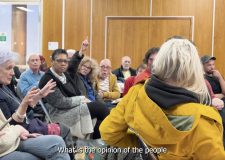How green are Brighton and Hove’s Greens?
Is the honeymoon over? Is the Green Party able to sustain its environmentally friendly credentials when faced with the tough task of governing? Is the process of exercising power crushing the hopes and dreams of the party’s supporters? Have they promised more than they can deliver? And are they now facing a sobering reality check?
These are some of the questions being asked of the politicians who formed an administration – without the comfort of a majority – after the local elections in May.
Careful targeting and precision campaigning, with a few lucky breaks, saw the Greens sweep from office the previous Conservative administration, which had also run Brighton and Hove City Council without a majority.
The election of the Greens was greeted with good-natured fascination in some quarters. Those who had become disillusioned with the mainstream parties welcomed the newcomers as a breath of fresh air.
In turn, they basked in the warmth of this appreciation much as Tony Blair did in that bright new dawn in 1997 when Labour came to office after 18 years in opposition. And as David Cameron did briefly after 13 years of Labour.
 The novelty of Greens in control attracted outside interest too, just as the election of Caroline Lucas as the country’s first Green MP had done a year before.
The novelty of Greens in control attracted outside interest too, just as the election of Caroline Lucas as the country’s first Green MP had done a year before.
There was something of a honeymoon period. This is not to say that their opponents were uncritical nor that everyone was cheering them on.
Some of those in the defeated parties seemed unsurprisingly deflated in the wake of their polling day disappointments.
But by the start of the summer holidays they were picking up the pace again. And since the start of last month it would be fair to say that normal business has been resumed.
The hullabaloo over travellers began almost at once. Increasingly, it has contributed to the feeling that the honeymoon is over although the fading glow is in part down to the passage of time. And in part it is down to the drip drip effect of a series of criticisms.
When it comes to travellers, the Greens’ rivals have used the party’s perceived tolerance as a stick with which to beat them.
It has very much been about perceptions though as the council’s approach to this issue has yet to change in any substantial or meaningful way. Given an overcrowded public meeting and a well attended protest in the past month, you could be forgiven for thinking otherwise.
The difference is that the Greens are now the authority figures and, despite the populist refrain in the background, are keen to tackle a real and visible problem.
Their opponents have engaged in mischief-making at times – a valid tactic in opposition – and even last week feelings on the subject were running high at a meeting of councillors.
The Greens accept that the travellers issue is unlikely ever to be totally solved. But, as one cabinet member said recently, that doesn’t mean that they won’t try to do the right thing and look for a suitable site for travellers.
Then came country matters. Plans to employ in-house staff to manage the council’s downland estate in place of the contracted specialist land agents provoked a stir.
The extra cost was a factor in the criticisms at this time of austerity. Perhaps more significantly, the Greens were accused of sacrificing an effective rural policy for a vanity project which would ultimately undermine environmentally sound achievements.
The Greens, however, believed otherwise and stuck to their guns.
In the past week three policy proposals have prompted their political opponents to accuse them of – at best – expediency. They relate to
- plans for new housing on a greenfield site
- a declaration on the principle of a park and ride and
- the draft strategy for the way we deal with our waste
The first two topics were each the subject of one of the four policy options papers published as the council prepares its new “City Plan”.
They represent a departure from the position previously adopted by the council. As a result the council yesterday started a period of public consultation about these changes.
A second stage of consultation will take place on the broader City Plan next year.
The onus is on the public to make known its views.
The third topic – what we do with our rubbish – will also be the subject of a consultation starting in just over a week’s time and lasting for six weeks.
These strategic planning documents may sound rather dry, dusty and arcane. But they are crucially important as they dictate what sort of buildings we can expect developers to build in various locations around our city. And where rubbish will be stored and processed and what will happen to it.
They set out the principles. When developers ask for detailed planning permission, they will be judged against the City Plan.
So just how did the Greens end up coming under fire?
Some of it comes down to our adversarial style of politics. One party rules. The rest oppose. But that’s just part of the answer.
Whichever party runs the council, it has to do so within all sorts of constraints – government policy, strict financial rules and, of course, the law. And the law places all manner of duties on councils and councillors, often leaving them with surprisingly little room for manoeuvre.
Take housing. The council has for some years been subject to house-building targets set at regional level, that is, by an organisation planning for the whole of the South East.
Since the credit crunch three years ago Brighton and Hove has fallen short of its targets.
Besides, there is only so much land in our densely populated city between the Downs and the sea.
One solution is to allow taller buildings. These don’t always prove popular, especially with people living near the chosen sites. And they’re not cheap.
Three schemes at Brighton Marina and the King Alfred are cases in point. Even though two of the three schemes were granted planning permission, one of those was subsequently scrapped and work on the other has been deferred.
 The Greens have been portrayed as anti-development and anti-business. The party regards these as myths that it is trying to dispel.
The Greens have been portrayed as anti-development and anti-business. The party regards these as myths that it is trying to dispel.
The council’s deputy leader, Councillor Amy Kennedy, has spelt out the position on a number of occasions, most recently just two weeks ago.
She said that her party wanted to create jobs and build homes and the option papers would provide a framework for doing so.
Earlier this year she told fellow councillors: “The city is open for business.”
And she tried to reassure investors that the Greens were keen to see development, subject to it being the right kind of development in the right place. And, of course, provided it meets increasingly stringent environmental conditions.
The Greens’ local election manifesto committed the party to begin building at least a thousand new affordable homes by the next local elections in 2015. This recognises the housing shortage in Brighton and Hove.
The government is abolishing the regional housing targets – which included affordable homes as well as those which, for many of us, seem increasingly unaffordable.
But the Greens don’t get off that lightly. The government now requires the council to assess and plan to meet the full range of current and future housing requirements in terms of need and demand. And to presume in favour of sustainable development.
How many homes do we need?
Under the old system we were looking at a target of 11,200 homes by 2030 which would mean building more than 500 a year.
The rules governing the new system seem to indicate a need to build between 16,000 and 19,000 new homes by 2030.
An assessment of available land locally suggests a capacity for about 8,000 properties.
A compromise being considered – the Greens’ preferred option – would keep the target at about 11,000.
To reach that figure, one solution, say the Greens, is to build 750 homes on a greenfield site called Toad’s Hole Valley in Hangleton by the A27 Brighton bypass.
The preferred option does not take into account proposals to build housing at Shoreham Harbour. This is where the party comes in for flak.
 Councillor Gill Mitchell, leader of the Labour group on the council, told a meeting of the Green cabinet: “We would prefer to look at the target of 400 to 2,000 overall at Shoreham Harbour, which is a brownfield site, rather than rushing to offer up Toad’s Hole Valley.
Councillor Gill Mitchell, leader of the Labour group on the council, told a meeting of the Green cabinet: “We would prefer to look at the target of 400 to 2,000 overall at Shoreham Harbour, which is a brownfield site, rather than rushing to offer up Toad’s Hole Valley.
“This will not protect other greenfield sites on the urban fringe.
“I really do have to point out this spectacular U-turn on behalf of your party.”
She quoted Councillor Pete West – now the council’s cabinet member for the environment – from a debate on the subject two years ago when he was in opposition.
He had spoken about the urban fringe, which includes sites like Toad’s Hole Valley, saying: “It should not be available to meet our housing targets even as a last resort. It would be a mark of our civilisation not to develop it.”
Fellow Labour member, Councillor Brian Fitch, who represents Hangleton and Knoll, said: “Before you turn this green area into a grey area, let’s look at brownfield sites.”
Councillor Mitchell castigated the cabinet, saying that at the local elections, “you trumpeted your green credentials and the voters took you at your word”.
Now, she said, the Greens were siding with the Tory government to concrete over the urban fringe. The Greens said that their plans would enable them to protect other similar sites.
Councillor Mitchell also slated her political opponents for removing the prospect of a park and ride scheme from the draft City Plan.
She pointed out the rise in traffic that might be expected if, say, Brighton and Hove Albion won planning permission to add 8,000 seats to their new stadium at Falmer.
The Greens said that extensive searches had failed to find any suitable sites, the cost would be too much and that in any event two thirds of car journeys started and ended within Brighton and Hove.
They said that the business community supported them on this subject.
And a report has suggested that they are contemplating putting up car parking charges as one way of discouraging drivers.
And when it came to the draft waste plan, the Greens were again left with little wriggle-room. They appeared to have accepted the need for incineration.
Councillor Mitchell was scathing: “When the Newhaven incinerator was being proposed you said if you had 100 per cent recycling you wouldn’t need an incinerator.
“This is another U-turn. You’re making so many you’re making the rest of us giddy.
“You had a chance to take out Hangleton Bottom (as a possible rubbish handling site) but you haven’t done. You campaigned vociferously against the use of (Hollingdean) for waste. That’s another policy that’s been binned.”
In defence of the Greens, one council insider said that some of the questions posed to the cabinet had been disingenuous.
Locations that had been earmarked previously were mentioned but choices about locations were to be made at a later date. He added that the Greens had inherited a number of policies from the Conservatives and in some cases had been pragmatic and stuck with them.
He said that the waste plan was a joint plan – and involved East Sussex County Council and West Sussex County Council. And he added that Brighton and Hove could expect to have its own more localised and ambitious waste plan in the near future.
After the cabinet meeting one local resident said: “Hubris comes in all shades including green.”
But a Green campaigner defended the party’s record and the way in which it was trying to encourage sustainable living while helping the local economy grow and creating local jobs.
Yes, the cabinet faced tough choices. Members were having to make decisions rather than just voice criticisms. Inevitably, after even a short while in office, some of the electorate would fall out of love with the party.
But there was a confidence that the party would find a way to put into practice many of the policies in the local election manifesto even if it did suffer the occasional setback and pragmatically come up with the occasional compromise.
“We’re listening to what people say and, when necessary, we’re adjusting our approach accordingly. We think that’s the democratic way to proceed.”




















